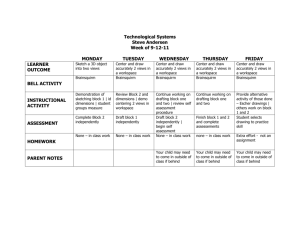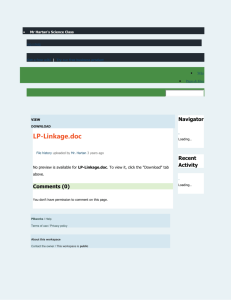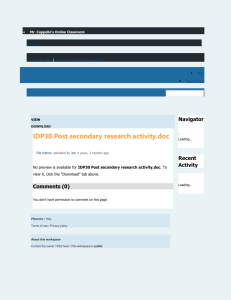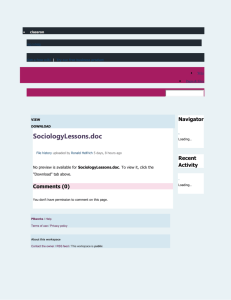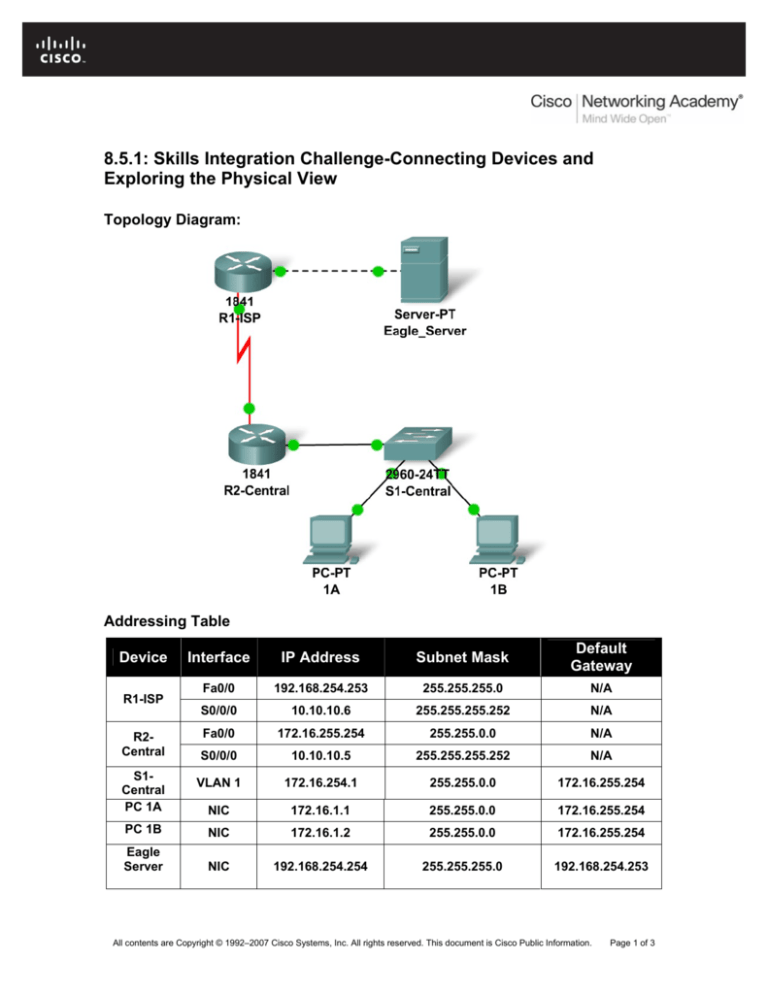
8.5.1: Skills Integration Challenge-Connecting Devices and
Exploring the Physical View
Topology Diagram:
Addressing Table
Interface
IP Address
Subnet Mask
Default
Gateway
Fa0/0
192.168.254.253
255.255.255.0
N/A
S0/0/0
10.10.10.6
255.255.255.252
N/A
Fa0/0
172.16.255.254
255.255.0.0
N/A
S0/0/0
10.10.10.5
255.255.255.252
N/A
VLAN 1
172.16.254.1
255.255.0.0
172.16.255.254
NIC
172.16.1.1
255.255.0.0
172.16.255.254
PC 1B
NIC
172.16.1.2
255.255.0.0
172.16.255.254
Eagle
Server
NIC
192.168.254.254
255.255.255.0
192.168.254.253
Device
R1-ISP
R2Central
S1Central
PC 1A
All contents are Copyright © 1992–2007 Cisco Systems, Inc. All rights reserved. This document is Cisco Public Information.
Page 1 of 3
CCNA Exploration
Network Fundamentals:
OSI Physical Layer
8.5.1: Skills Integration Challenge-Connecting Devices and Exploring the Physical View
Learning Objectives
•
•
Connect the devices in the standard lab setup
o Connect the devices
o Verify connectivity
View the standard lab setup in the Physical Workspace
o Enter and view the Physical Workspace
o View the standard lab setup at the various levels of the Physical Workspace
Introduction
When working in Packet Tracer, in a lab environment, or in a corporate setting it is important to
know how to select the proper cable and how to properly connect devices. This activity will
examine device configurations in Packet Tracer, select the proper cable based on the
configuration, and connect the devices. This activity will also explore the physical view of the
network in Packet Tracer.
Task 1: Connect the Devices in the Standard Lab Setup.
Step 1: Connect the devices.
Connect PC 1A to the first port on switch S1-Central and PC 1B to the second port on switch S1Central using the proper cable.
Click on router R2-Central and examine the configuration using the Config tab. Connect the
proper interface on the router to Interface FastEthernet0/24 on switch S1-Central using the proper
cable.
Click on both routers and examine the configuration using the Config tab. Connect the routers
together using the proper interfaces and the proper cable
Click on router R1-ISP and examine the configuration using the Config tab. Connect the proper
interface on the router to the proper interface on Eagle Server using the proper cable.
Step 2: Verify connectivity.
From the Command Prompt on the Desktop of both PCs issue the command ping
192.168.254.254, the IP address of Eagle Server. If the pings fail, check your connections and
troubleshoot until the pings succeeds. Check your configuration by clicking the Check Results
button.
Task 2: View the Standard Lab Setup in the Physical Workspace.
Step 1: Enter and view the Physical Workspace.
Most of our work in Packet Tracer has been done in the Logical Workspace. In an internetwork,
routers maybe in different sites from across the street to across the globe. The serial link between
the routers represents a dedicated leased line between two locations consisting of a DTE (Data
Terminal Equipment), such as a router, connected to a DCE (Data Communication Equipment),
such as a CSU/DSU or modem. The DCE connects to a service provider's local loop and the
connections are repeated at the other end of the link. The Physical Workspace allows us to see
these relationships more clearly.
All contents are Copyright © 1992–2007 Cisco Systems, Inc. All rights reserved. This document is Cisco Public Information.
Page 2 of 3
CCNA Exploration
Network Fundamentals:
OSI Physical Layer
8.5.1: Skills Integration Challenge-Connecting Devices and Exploring the Physical View
Enter the Physical Workspace by clicking the tab in the upper left hand corner of the Workspace.
It shows the connection between Central City and ISP City.
Step 2: View the standard lab setup at the various levels of the Physical Workspace.
Click on the Central City, it shows the city and the location of the Central Office building. Click on
the Central Office building, it shows the floor plan of the building and the location of the Wiring
Closet. Click on the Wiring Closet, it shows a physical representation of the equipment installed in
the wiring closet and the cabling that connects the equipment. Examine this view of the topology.
Click on Intercity on the Navigation bar. Repeat the steps to view the equipment installed in ISP
City.
All contents are Copyright © 1992–2007 Cisco Systems, Inc. All rights reserved. This document is Cisco Public Information.
Page 3 of 3


